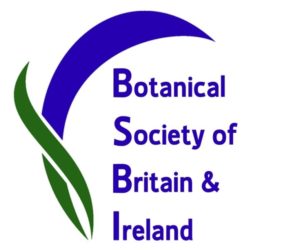Kirkcudbrightshire Botany Group at Wood of Cree, 9th June 2023
Our meeting was held at the kind invitation of RSPB. The main objective of the day was to count the clumps of Elongated Sedge Carex elongata (also known as Gingerbread Sedge). This is a scarce species of which the Wood of Cree holds a significant population. Our count was intended to provide a baseline against which any future changes can be measured and will contribute to the reserve management plan.
The habitat of the Elongated Sedge is a strip of very wet woodland between the road and the river, where it grows with another scarce species, Water Sedge Carex aquatilis. As our visit came after a prolonged dry spell of weather, access to this area was easier than it might otherwise have been. The count methodology was for a group of four people to walk abreast, parallel to the edge of the river and spanning the narrow strip of woodland between them. Every sedge tussock in flower was counted using hand-held tally counters. Counters had to carefully distinguish between Elongated Sedge and two other tufted species: Remote Sedge Carex remota and Tufted Hair-grass Deschampsia cespitosa. To be certain of correct identification, only flowering sedge clumps were counted.
Sections of woodland were counted by two teams of four people each. The southern section immediately north of the main car park yielded a total of 63 tussocks and the northern one beyond the stream totalled over 800. (A third section to the north remains to be counted). This total exceeded our expectations and we were also pleased to note the presence of plenty of smaller clumps which were not yet flowering and were assumed to be younger plants, showing that there was recruitment to the population. Fortunately this sedge grows in discrete tussocks, making it easier to count than other species. However we felt that it might have been even easier had we done the count a week or two earlier before adjacent vegetation had overtopped it.
Special thanks are due to the volunteers who did the counting. It was quite tough scrambling through the tangle of branches and tall vegetation; they did a fantastic job and made an important contribution to the conservation of this plant.
One of our counters, Sue, suggested that the sedge should be re-named ‘Goldilocks Sedge’ as it seemed to prefer a very precise strip of woodland habitat mid-way between the river and the road.
While the sedge count was taking place, a second group recorded plants in an area of mire above the road around Cairns Hill (NX3772). It is bordered by oak-hazel woodland in a shallow depression surrounded by low rock ridges, with two small seeps or springs feeding into it. From the vegetation seen, it appears to be periodically flooded, indicated by the presence of Bogbean Menyanthes trifoliata, Marsh Cinquefoil Comarum palustre and a few patches of Bog Pondweed Potamogeton polygonifolius. A notable feature of the flushes was the presence of Tawny Sedge Carex hostiana, described in the manuals as occurring “where water contains a fairly high proportion of bases and has a pH of 5.5-6.5”. It seems likely that its presence here is a result of the Calc-Alk igneous intrusion which forms the surrounding rock ridges. It was also accompanied by Marsh Arrow-grass Triglochin palustre. Elsewhere there was Bog Myrtle Myrica gale, both cottongrasses, Hare’s-tail Cottongrass Eriophorum vaginatum and Common Cottongrass E. angustifolium, Round-leaved Sundew Drosera rotundifolia, Bog Asphodel Narthecium ossifragum and Deergrass Trichophorum germanicum, all typical of very acid ground. And there was a fine display of Heath Spotted-orchids Dactylorhiza maculata, in varying shades of pale pink, including two large spikes of a very deep pink. The vegetation is dependent on grazing for short periods of time with the various shrubs like Bog Myrtle and Eared Willow Salix aurita being kept in check by the cattle. Removal of grazing would eventually lead to the mire becoming wet woodland with the loss of floral diversity as at present.
We also recorded the vegetation of the oak woodland on the way up to the site but there was nothing outstanding to report.
At the end of the morning the two groups joined together to take lunch down to the northernmost of the two Dow Lochs where there is another lovely open area of mire with a good mix of species including Bottle Sedge Carex rostrata, Bladder-sedge C. vesicaria, White Sedge C. canescens, Marsh Cinquefoil Comarum palustre, Bogbean Menyanthes trifoliata, and Marsh St John’s-wort Hypericum elodes.
On the way down to the loch, Jim paused to relocate a population of Mountain Melick Melica nutans which he had found there three years ago. There were a good number of scattered clumps, between the layby on the road and the edge of the woodland bordering the marsh around the Dow Lochs.
This was a very enjoyable day at a beautiful reserve and there was a great turn-out of KBG members. Many thanks to everyone who came along and in particular to Gavin Chambers and the RSPB team.
Sarah White
Post Script
David has added the following notes about the two rare plants recorded at this meeting:
Melica nutans – Classified as Locally Scarce (<11 sites in the VC)
Since 1983 there have been only 6 sites recorded in the VC but none formally recorded at Wood of Cree since 1963 (NX3771) and 1966 (NX3871). Jim McCleary however found it there 7th June 2020.
Carex elongata – Classified as Nationally Scarce (fewer than 100 sites in the UK) and Locally Rare (<4 sites in the VC).
There are just 2 sites in VC73, both on RSPB Reserves.
Largest known population in UK is Askham Bog, Yorkshire, with over 6000 plants at the last count, and apparently increasing (Fitter et al, 2021). The plant rarely sets seed and relies mainly on vegetative spread (Atlas 2023).
Fitter, A. et al, 2021. The Status of Carex elongata (Cyperaceae) in Yorkshire. British & Irish Botany 3(4): 482-489.

